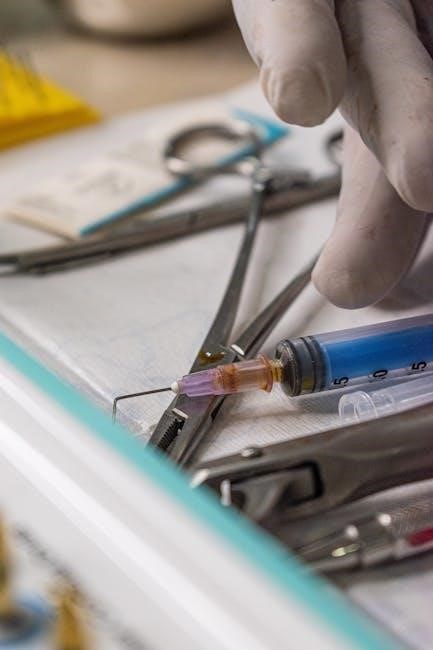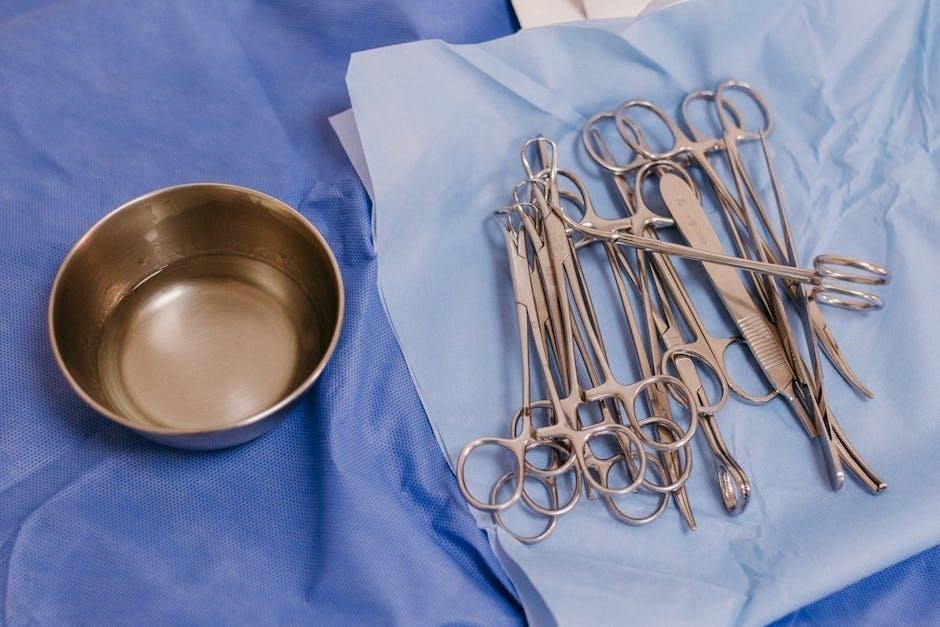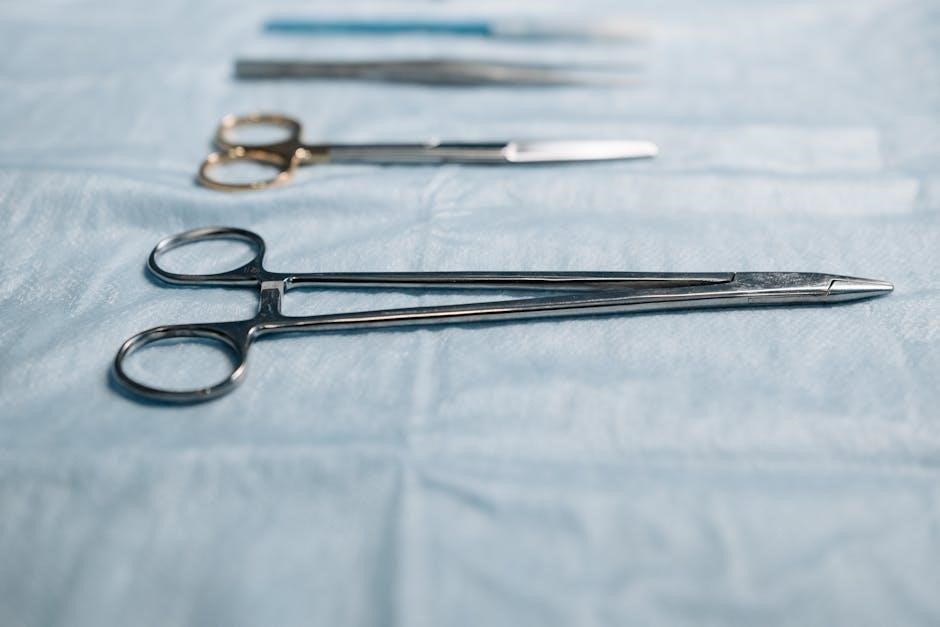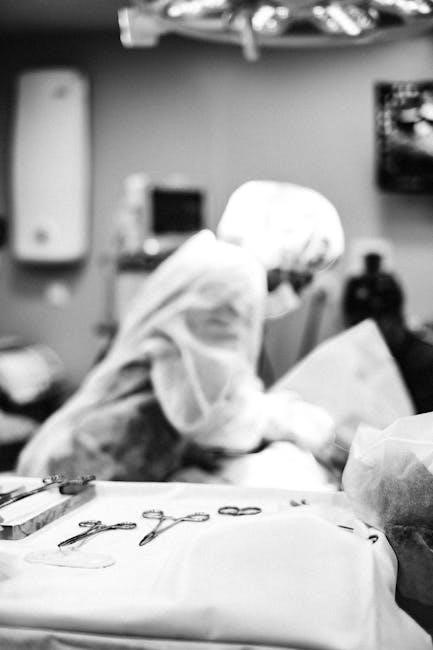The 54 basic surgical instruments are foundational tools in surgical practice, designed to ensure precision, control, and safety during procedures. These instruments, while often overlooked, are the unsung heroes of healing.
1.1 Overview of Surgical Instruments
Surgical instruments are the backbone of surgical practice, enabling precise and effective medical interventions. The 54 basic surgical instruments represent the core tools essential for every operating room. These instruments are categorized into four main groups: cutting/dissecting, clamping/occluding, grasping/holding, and suturing/stapling. Each tool is meticulously crafted to serve specific functions, ensuring surgeons can perform tasks like incisions, tissue handling, and wound closure with accuracy. Their design and functionality are vital for successful surgical outcomes, making them indispensable in modern healthcare. These instruments empower surgeons to diagnose and treat a wide range of conditions, ultimately improving patient care and recovery.
1.2 Importance of Basic Surgical Instruments
Basic surgical instruments are indispensable in ensuring the success and safety of medical procedures. They provide surgeons with the precision and control needed for delicate tasks, such as making incisions, dissecting tissue, and suturing. These tools are essential for maintaining sterility, minimizing tissue damage, and promoting efficient workflows in the operating room. Without them, modern surgery would lack the foundational capabilities required to treat a wide range of conditions. Their importance extends beyond functionality, as they directly impact patient outcomes, recovery times, and overall surgical success. Thus, understanding and mastering these instruments is crucial for every surgical professional.
1.3 Evolution of Surgical Tools
The evolution of surgical tools has been a gradual process shaped by advancements in medical knowledge, materials science, and technological innovation. Early surgical instruments, often crude and rudimentary, were crafted from materials like bronze and steel. The 19th century brought significant improvements with the introduction of stainless steel, reducing corrosion and improving sterility. The 20th century saw the development of specialized instruments tailored for specific procedures, enhancing precision and functionality. Today, modern surgical tools incorporate advanced materials like titanium and robotics, offering unparalleled performance. This evolution underscores the adaptability and ingenuity of surgical instrumentation, ensuring better patient outcomes and safer procedures.
Categories of Surgical Instruments
Surgical instruments are categorized into four main groups: Cutting and Dissecting, Clamping and Occluding, Grasping and Holding, and Suturing and Stapling, each serving distinct functional purposes.
2.1 Cutting and Dissecting Instruments
Cutting and dissecting instruments are essential for making precise incisions and separating tissue during surgical procedures. These tools include scalpels, surgical scissors, and knives, each designed for specific tasks. Scalpels are typically used for initial incisions, while scissors like Mayo and Metzenbaum scissors are utilized for cutting sutures or dissecting tissue. These instruments are crafted from high-quality materials, such as high-carbon stainless steel, to ensure sharpness and durability. Their versatility allows them to be used in various surgical specialties, making them indispensable in the operating room for achieving accurate and efficient tissue manipulation; Proper handling and maintenance are crucial to uphold their performance.
2.2 Clamping and Occluding Instruments
Clamping and occluding instruments are vital for controlling bleeding and securing tissues during surgery. Forceps, such as Allis and Babcock, are commonly used to grasp and hold tissues or objects firmly. Clamps like Rochester and Kelly clamps are employed to control blood vessels or structures, preventing excessive bleeding. These tools are designed with precision to minimize tissue damage while maintaining a secure grip. Their robust construction from materials like high-carbon stainless steel ensures durability and reliability. Clamping and occluding instruments play a critical role in maintaining clear surgical sites and preventing complications, making them indispensable in various surgical procedures. Proper selection and application are essential for optimal outcomes.
2.3 Grasping and Holding Instruments
Grasping and holding instruments are essential for securely gripping tissues or objects during surgical procedures. These tools are designed to minimize tissue trauma while providing a firm hold. Common examples include Allis forceps, used for delicate tissues, and Babcock forceps, ideal for larger tissue masses. The ergonomic design of these instruments enhances control and precision, reducing fatigue during prolonged surgeries. Constructed from high-quality materials like stainless steel, they ensure durability and resistance to corrosion. Proper use of grasping and holding instruments is critical for maintaining tissue integrity and facilitating smooth surgical progress. They are indispensable in various specialties, offering versatility and reliability.
2.4 Suturing and Stapling Instruments
Suturing and stapling instruments are vital for closing wounds and joining tissues during surgical procedures. These tools are designed to ensure precise and secure closure, minimizing tissue damage and promoting healing. Needle holders, such as the Mayo-Hegar and Halsey, are used to grip and maneuver sutures with ease. Surgical staplers, including linear and circular types, offer rapid and consistent closure, especially in minimally invasive surgeries. These instruments are crafted for durability and ergonomic comfort, enabling surgeons to perform suturing and stapling with accuracy. Their role is critical in both traditional and advanced surgical techniques, ensuring optimal outcomes and reducing post-operative complications.

Ratcheted Forceps
Ratcheted forceps are essential surgical tools designed for secure tissue gripping and controlled holding during procedures, ensuring precision and stability in various medical operations.
3.1 Allis Forceps
Allis forceps are versatile, ratcheted instruments used in various surgical procedures for tissue grasping and retracting. Their interlocking teeth provide a firm grip, minimizing tissue trauma. Commonly employed in abdominal and gynecological surgeries, these forceps are valued for their reliability and precision. The ratchet mechanism allows for easy adjustment, ensuring secure tissue control. Their design enhances surgical efficiency, making them a cornerstone in the operating room. Surgeons rely on Allis forceps for precise tissue handling, contributing to successful procedural outcomes.
3.2 Babcock Forceps
Babcock forceps are specialized surgical instruments designed for gentle yet secure tissue grasping. Their curved or angled jaws, equipped with smooth, interlocking teeth, minimize tissue trauma while maintaining a firm grip. Commonly used in abdominal, gynecological, and laparoscopic procedures, these forceps are ideal for delicate tissues. The ratchet mechanism allows for precise control, enhancing surgical dexterity. Unlike Allis forceps, Babcock forceps are preferred for their versatility in both open and minimally invasive surgeries. Their reliability and gentle handling make them indispensable in the operating room, ensuring efficient tissue manipulation during complex procedures.
3.3 Dunhills Forceps
Dunhills forceps are versatile surgical instruments designed for secure tissue grasping and manipulation. Their curved or straight jaws, often with serrated edges, provide a firm grip without causing significant tissue trauma. These forceps are commonly used in general surgery, gynecology, and urology for procedures involving delicate tissues or small objects. The ratchet mechanism allows for precise control, enabling surgeons to handle tissue with confidence. Dunhills forceps are valued for their durability and ease of use, making them a reliable choice in various surgical settings. Their design ensures minimal slippage, enhancing surgical precision and efficiency during procedures.
3.4 Lane Tissue Forceps
Lane tissue forceps are specialized surgical instruments designed for handling delicate tissues with precision. Their curved or straight jaws, often serrated, provide a secure grip without causing excessive tissue damage. These forceps are widely used in various surgical procedures, including skin closure and plastic surgery, where gentle tissue manipulation is critical. The ratchet mechanism ensures a firm hold, allowing surgeons to work confidently. Lane tissue forceps are valued for their balance and ergonomic design, making them a preferred choice for procedures requiring careful tissue handling; Their versatility and reliability make them indispensable in modern surgical practices.
3.5 Littlewoods Forceps
Littlewoods forceps are a type of tissue forceps designed for secure gripping of tissues during surgical procedures. They feature interlocking teeth that provide a firm hold, minimizing the risk of tissue slippage. These forceps are particularly useful in general surgery and laparoscopic procedures, where precise tissue manipulation is essential. Their lightweight design and ergonomic handles reduce fatigue, allowing surgeons to work comfortably over extended periods. Littlewoods forceps are valued for their durability and versatility, making them a reliable choice in various surgical settings. Their ability to handle delicate tissues with care ensures optimal outcomes in both routine and complex surgeries.
3.6 Sawtell Forceps
Sawtell forceps are specialized surgical instruments designed for precise tissue handling and manipulation. Their unique design features a curved or angled tip, which allows for better access and control in deep or confined surgical sites. These forceps are commonly used in procedures requiring delicate tissue dissection, such as gynecologic or urologic surgeries. The serrated jaws provide a secure grip, minimizing tissue trauma. Sawtell forceps are valued for their versatility and are often preferred in minimally invasive surgeries due to their ergonomic design and ability to enhance surgical precision. Their durability and ease of use make them a trusted choice among surgeons.
3.7 Spencer Wells Forceps
Spencer Wells forceps are a type of ratcheted surgical instrument commonly used for clamping and holding tissues or objects during procedures. Their sturdy design features interlocking teeth, which provide a secure grip, making them ideal for controlling bleeding or manipulating tissue. These forceps are widely used in general surgery, gynecology, and urology due to their versatility. The ratchet mechanism allows for precise control, ensuring minimal tissue trauma. Spencer Wells forceps are a favorite among surgeons for their reliability and ease of use in various surgical settings. Their durability and ergonomic design make them a essential tool in the operating room.
Non-Ratcheted Forceps
Non-ratcheted forceps are lightweight, non-locking instruments used for delicate tissue handling. They are ideal for precise procedures, offering superior control without the bulk of ratcheted designs.
4.1 Debakey Forceps
The DeBakey Forceps are a type of non-ratcheted instrument known for their gentle yet firm grip. They feature long, curved or straight shafts with atraumatic jaws to minimize tissue trauma. Commonly used in cardiovascular and general surgeries, these forceps are ideal for handling delicate tissues, such as blood vessels or nerves. Their precise control and smooth action make them indispensable in procedures requiring meticulous care. Available in various lengths and jaw types, DeBakey Forceps are tailored to meet specific surgical demands, ensuring optimal performance in the operating room.
4.2 Lanes Forceps
Lanes Forceps are non-ratcheted, tissue-handling instruments designed for secure yet gentle gripping. They feature interlocking teeth that provide a firm grasp without causing significant tissue trauma. Commonly used in general and specialized surgeries, these forceps are valued for their precise control and versatility. Available in various shaft lengths and jaw types, Lanes Forceps adapt to different surgical scenarios, making them indispensable in the operating room. Their durability and ergonomic design ensure reliable performance, contributing to efficient and safe surgical procedures.
4.3 Gillies Forceps
Gillies Forceps are non-ratcheted, tissue-handling instruments designed for secure gripping and precise control. They feature smooth, rounded jaws that minimize tissue trauma, making them ideal for delicate procedures. Commonly used in neurosurgery and plastic surgery, these forceps are valued for their lightweight design and ease of use. The spring handle provides a firm yet gentle grip, allowing for precise manipulation of tissue. Gillies Forceps are essential for procedures requiring minimal tissue damage, ensuring optimal outcomes. Their simplicity and effectiveness make them a cornerstone in surgical instrumentation, relied upon by surgeons for intricate and demanding operations.

Scissors
Surgical scissors are versatile cutting tools essential in various procedures. Available in curved or straight designs, they precisely cut tissues, sutures, or dressings, ensuring accuracy and control.
5.1 Mayo Scissors
Mayo Scissors are a type of surgical scissors with straight blades and blunt tips, used for cutting sutures or heavy tissues. They are durable, versatile, and essential in various procedures, offering precision and control. Their straight design allows for effective cutting in tight spaces, making them a favorite among surgeons. Constructed from high-quality stainless steel, Mayo Scissors are known for their longevity and ease of use. They are a critical tool in every operating room, enabling surgeons to perform tasks efficiently and safely. Their ergonomic handles reduce fatigue, ensuring comfort during prolonged surgeries.
5.2 McIndoe Scissors
McIndoe Scissors are curved, blunt-tipped surgical scissors designed for precise dissection and cutting of finer tissues. They are particularly useful in delicate procedures, such as skin grafts or plastic surgery. The curved blades allow for accurate manipulation in confined spaces, while the blunt tips prevent unintended tissue damage. McIndoe Scissors are valued for their durability and ergonomic design, which reduces hand fatigue during prolonged use. They are an essential tool in the surgeon’s arsenal, enabling meticulous control and precision in intricate surgical tasks. Their versatility makes them a cornerstone in modern surgical instrumentation.

Retractors
Retractors are essential surgical instruments used to expose surgical sites by holding tissues apart. They come in various types, each designed for specific procedures, ensuring optimal access and visibility.
6.1 Langenbeck Retractor
The Langenbeck Retractor is a curved, flat surgical instrument used to retract and expose deeper tissue layers. Its broad blade provides excellent visibility in abdominal and pelvic procedures. Designed for gentle tissue handling, it minimizes trauma and ensures precise control. Commonly used in general surgery, it is a versatile tool that enhances access during complex operations, making it an indispensable asset in the operating room for surgeons seeking optimal exposure with minimal tissue damage. Its simplicity and effectiveness have made it a preferred choice among medical professionals.
6.2 Norfolk and Norwich Retractor
The Norfolk and Norwich Retractor is a specialized surgical tool designed to provide optimal tissue exposure during procedures. Its unique angled design allows for precise retraction in confined spaces, making it highly effective in orthopedic, neurosurgical, and ENT surgeries. The instrument features a sturdy construction with a curved blade, ensuring minimal tissue trauma while maintaining excellent visibility. Its ergonomic handle offers comfortable grip and control, reducing surgeon fatigue. Widely regarded for its versatility, the Norfolk and Norwich Retractor is a crucial instrument in modern surgical settings, enabling surgeons to access complex anatomical structures with ease and precision.
6.3 Travers Retractor
The Travers Retractor is a versatile surgical tool designed for optimal tissue exposure during procedures. Its unique design features a flexible blade that allows for precise retraction in various surgical contexts. Commonly used in abdominal and cardiovascular surgeries, this retractor provides excellent visibility while minimizing tissue trauma. The ergonomic handle ensures a comfortable grip, reducing surgeon fatigue during prolonged operations. Its durability and ease of use make it a preferred choice among surgeons for achieving reliable tissue retraction in complex surgical environments.

Other Essential Instruments
These instruments are crucial for supporting surgical procedures, ensuring efficiency and precision. They include tools like needle holders, Rampley sponge holders, and towel clips, each serving unique roles.
7.1 Needle Holders
Needle holders are critical tools in surgical procedures, designed to securely grip and manipulate surgical needles. They typically feature a sturdy jaw mechanism and a locking system to ensure a firm grip, preventing the needle from slipping during suturing. Available in various sizes and jaw types, needle holders are tailored for different tissue thicknesses and surgical specialties. Their ergonomic design enhances precision and control, making them indispensable in both general and specialized surgeries. Proper use of needle holders is essential for maintaining surgical efficiency and minimizing operative time. They are a cornerstone in the arsenal of surgical instruments, ensuring accurate and secure suturing.
7.2 Rampley Sponge Holding
Rampley sponge holders are essential tools in surgical procedures, primarily used for holding and manipulating surgical sponges to control bleeding and absorb fluids. These instruments feature a slender, curved or straight design with a secure gripping mechanism at the tip, ensuring a firm hold on sponges. Available in various sizes, Rampley sponge holders are versatile, catering to different surgical needs. Their sturdy construction and ergonomic handles allow for precise control, making them invaluable in maintaining a clear surgical field. They play a critical role in reducing operative complications by effectively managing fluid absorption and tissue visibility, ensuring efficient surgical outcomes.
7.3 Towel Clips
Towel clips are small, sturdy instruments used to secure surgical drapes or towels in place during procedures. They ensure a stable and sterile surgical field, preventing unwanted movement of drapes. Available in straight or curved designs, towel clips are typically made of high-quality stainless steel for durability. Their strong gripping mechanism allows for a firm hold without tearing the material. Proper placement of towel clips is crucial for maintaining asepsis and preventing contamination; They are an indispensable tool in surgical settings, contributing to efficient and safe operative practices by keeping the surgical site clear and accessible for the surgical team.
Historical Impact of Surgical Instruments
The development of surgical instruments has significantly shaped medical history, enabling precise procedures and saving countless lives. Their evolution reflects human ingenuity and advancements in patient care.
8.1 Development of Surgical Tools
The development of surgical tools dates back to ancient civilizations, with early instruments crafted from materials like bronze and steel. Over centuries, advancements in metallurgy and design led to more precise and versatile instruments. The modern 54 basic surgical instruments represent a culmination of this evolution, incorporating ergonomic designs and advanced materials. These tools have transitioned from rudimentary devices to sophisticated instruments, enabling surgeons to perform complex procedures with greater accuracy and safety. Their historical development underscores the critical role of innovation in advancing surgical care and improving patient outcomes.
8.2 Impact on Medical Procedures
The 54 basic surgical instruments have revolutionized medical procedures by providing surgeons with the precision and control needed for intricate operations. These tools enable accurate incisions, effective tissue dissection, and secure suturing, minimizing trauma and promoting faster recovery. Their widespread adoption has standardized surgical practices, ensuring consistency and safety across procedures; By facilitating advanced techniques, these instruments have expanded the scope of surgical interventions, improving outcomes and saving countless lives. Their impact is evident in the precision, efficiency, and reliability they bring to modern surgical care.
Proper Care and Maintenance
Proper care and maintenance of surgical instruments involve thorough cleaning, sterilization, and storage. Regular handling and inspection ensure longevity and functionality, crucial for safe surgical procedures.
9.1 Cleaning and Sterilization
Proper cleaning and sterilization of surgical instruments are critical to prevent infection and maintain functionality. Instruments must be cleaned with ultrasonic cleaners or enzymatic solutions to remove debris. Sterilization methods include autoclaving or dry heat, ensuring all microorganisms are eliminated. Regular maintenance prevents corrosion and extends the lifespan of tools. Proper techniques guarantee patient safety and optimal performance during procedures. Adhering to these protocols is essential for upholding surgical standards and ensuring reliable instrumentation.
9;2 Storage and Handling
Proper storage and handling of surgical instruments are vital to maintain their functionality and longevity. Instruments should be stored in a clean, dry environment, preferably in protective cases or trays to prevent damage. Moisture can lead to rust, so thorough drying after sterilization is essential. Organizing instruments in logical groups or kits ensures easy access during procedures. Improper storage can result in corrosion or damage, compromising surgical outcomes. Handling instruments with care, avoiding overcrowding, and using appropriate materials for storage are critical to preserving their quality and ensuring they remain ready for use.

Future Trends in Surgical Instrumentation
Advancements in advanced materials and robotic instruments are revolutionizing surgical practices, offering enhanced precision and minimally invasive techniques, while improving patient outcomes and operational efficiency.
10.1 Advanced Materials
The integration of advanced materials into surgical instrumentation is transforming the field by enhancing durability, resistance, and biocompatibility. Lightweight, high-strength alloys and nanomaterials improve ergonomic design, reducing surgeon fatigue. These materials also enable precise engineering, ensuring instruments are both versatile and reliable. Furthermore, advanced coatings and antimicrobial surfaces minimize the risk of infection and extend instrument longevity. Innovations in biodegradable and self-lubricating materials are paving the way for sustainable and maintenance-free options. Such advancements not only elevate performance but also contribute to safer, more efficient surgical practices, aligning with the growing demand for minimally invasive and energy-efficient procedures.
10.2 Robotic Instruments
Robotic instruments are revolutionizing surgery by offering unparalleled precision and dexterity. These advanced tools, equipped with miniature robotic arms, enable surgeons to perform complex procedures with enhanced accuracy. Robotic systems integrate high-definition 3D imaging and AI, allowing for meticulous planning and execution. They minimize human error, reduce tissue damage, and improve patient outcomes. With ergonomic designs, robotic instruments also reduce surgeon fatigue, making lengthy procedures more manageable. Their scalability across various surgical specialties, such as cardio and neurosurgery, underscores their versatility. As technology evolves, robotic instruments are poised to become indispensable in modern surgical practices, setting new standards for minimally invasive care.